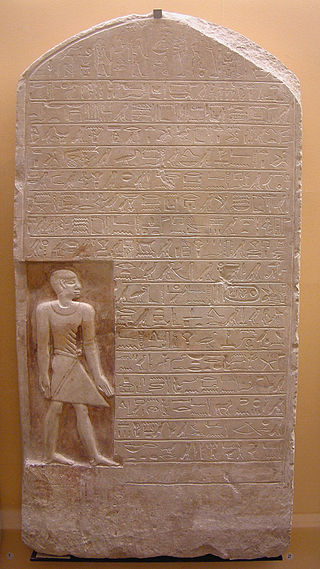Related Research Articles

Userkare Khendjer was a minor king of the early Thirteenth Dynasty of Egypt during the Middle Kingdom. Khendjer possibly reigned for four to five years, archaeological attestations show that he was on the throne for at least three or four years three months and five days. Khendjer had a small pyramid built for himself in Saqqara and it is therefore likely that his capital was in Memphis.

The Thirteenth Dynasty of ancient Egypt is often combined with Dynasties XI, XII and XIV under the group title Middle Kingdom. Some writers separate it from these dynasties and join it to Dynasties XIV through XVII as part of the Second Intermediate Period. Dynasty XIII lasted from approximately 1803 BC until approximately 1649 BC, i.e. for 154 years.

Sehetepkare Intef was the a minor king of the early 13th Dynasty during the late Middle Kingdom.

Khutawyre Wegaf was a pharaoh of the early Thirteenth Dynasty of Egypt in the late Middle Kingdom/Second Intermediate Period. He is known from several sources, including a stele and statues. In the Turin King List he is the first ruler of this dynasty with a reign of 2 regnal years.

Khaneferre Sobekhotep IV was one of the more powerful Egyptian kings of the 13th Dynasty, who reigned at least eight years. His brothers, Neferhotep I and Sihathor, were his predecessors on the throne, the latter having only ruled as coregent for a few months.

Sedjefakare Kay Amenemhat VII was an Egyptian pharaoh of the early 13th Dynasty in the late Middle Kingdom.

Sekhemre Khutawy Amenemhat Sobekhotep was an Egyptian pharaoh of the early 13th Dynasty.

Khaankhre Sobekhotep I was a pharaoh of the Thirteenth Dynasty of Egypt during the Second Intermediate Period.
Sekhemre Shedtawy Sobekemsaf II was an Egyptian king who reigned during the Second Intermediate Period, when Egypt was fragmented and ruled by multiple kings. He was once thought to belong to the late Thirteenth Dynasty, but is today believed to be placed as a king of the Seventeenth Dynasty of Egypt.
Kim Steven Bardrum Ryholt is a professor of Egyptology at the University of Copenhagen and a specialist on Egyptian history and literature. He is director of the research center Canon and Identity Formation in the Earliest Literate Societies under the University of Copenhagen Programme of Excellence and director of The Papyrus Carlsberg Collection & Project.

Sobekhotep III was an Egyptian king of the mid Thirteenth Dynasty of Egypt who reigned three to four years.

Ankhu was an Egyptian vizier during the early 13th Dynasty in the late Middle Kingdom. He is believed to have resided in Thebes in Upper Egypt.

Seankhibre Ameny Antef Amenemhat VI was an Egyptian pharaoh of the early Thirteenth Dynasty.

Aya was an ancient Egyptian king's wife of the early Thirteenth Dynasty.

Sekhemre Sementawy Djehuty was a minor king reigning over parts of Upper Egypt during the Second Intermediate Period.
This page list topics related to ancient Egypt.

Sewahenre Senebmiu is a poorly attested Egyptian pharaoh during the Second Intermediate Period, thought to belong to the late 13th Dynasty.

Aabeni was an ancient Egyptian official with the title high steward. He was one of the most important officials at the royal court in the early Thirteenth Dynasty.
Dedusobek Bebi was a high official of the late Thirteenth Dynasty of ancient Egypt. He became the "Great Scribe of the Vizier". This position was directly under the Vizier acting as a deputy.
Resseneb was a short-lived vizier in Upper Egypt during the 13th Dynasty, preceded by his father, the famous Ankhu, and succeeded by his brother Iymeru.
References
- ↑ https://pnm.uni-mainz.de/2/inscription/1034
- ↑ Allam: Hieratischer Papyrus Bulaq 18, 62, pls. 4, 13
- ↑ K.S.B. Ryholt, The Political Situation in Egypt during the Second Intermediate Period, c.1800-1550 BC, Carsten Niebuhr Institute Publications, vol. 20. Copenhagen: Museum Tusculanum Press, 1997
- ↑ Allam: Hieratischer Papyrus Bulaq 18. pl. 18a